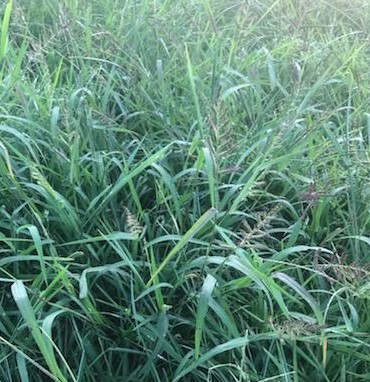By Libbie Johnson
In a newly established bahiagrass field, understanding and controlling weeds can be a formidable task, but is extremely necessary to obtain the best pasture. Recently, a cattleman expressed concern about a grass weed that was really filling out his newly established Argentine pasture. Based on his description of the grass (seedhead with multiple racemes, not the typical V-shape of bahiagrass), my first concern was that it could be
Brunswick grass. Brunswick grass appearing in newly planted bahiagrass fields has been of great concern to Extension personnel in recent years. In February 2016, Dr. Ann Blount published
Brunswick Grass: a Weed Contaminant in Bahiagrass Seed Production Fields in Panhandle Ag e-News. Alabama Extension also posted an article in August: Brunswick grass: A Weed in Southern Pastures & Bahiagrass Seed Fields. Both articles have excellent photos of the problematic grass.
Brunswick grass is a perennial summer grass, with a similar growing season and appearance to that of bahiagrass. However, Brunswick grass is unpalatable to cattle and not readily grazed. Control for Brunswick grass is difficult. Chemical options to selectively control Brunswick grass in bahiagrass are very limited and still being researched. The current recommendation of Hexazinone at 1 quart/acre is rather expensive and potentially problematic due to its activity on most desirable shade trees. Brunswick grass is an issue cattlemen don’t want to face.

The grower was asked to go home and take a few good pictures so an identification could be made and a control recommendations determined. The pictures show the actual weedy grass; it was barnyard grass (Echinochloa crus-galli), a warm season annual grass. The recommendation was to hay or mow the pasture, fertilize the bahia well, and continue to manage the field to promote the establishment of the bahiagrass. Utilizing the forage for natural weed control is WAY more economical than utilizing hexazinone. Dr. Jose Dubeux said, “Once the bahiagrass is fully established with good ground cover, it should prevent these annual grasses from coming up.”
In closing, producers, feel free to contact
your local Extension agent for assistance with weed identification. Let us try to help save you some money by getting the best recommendations.